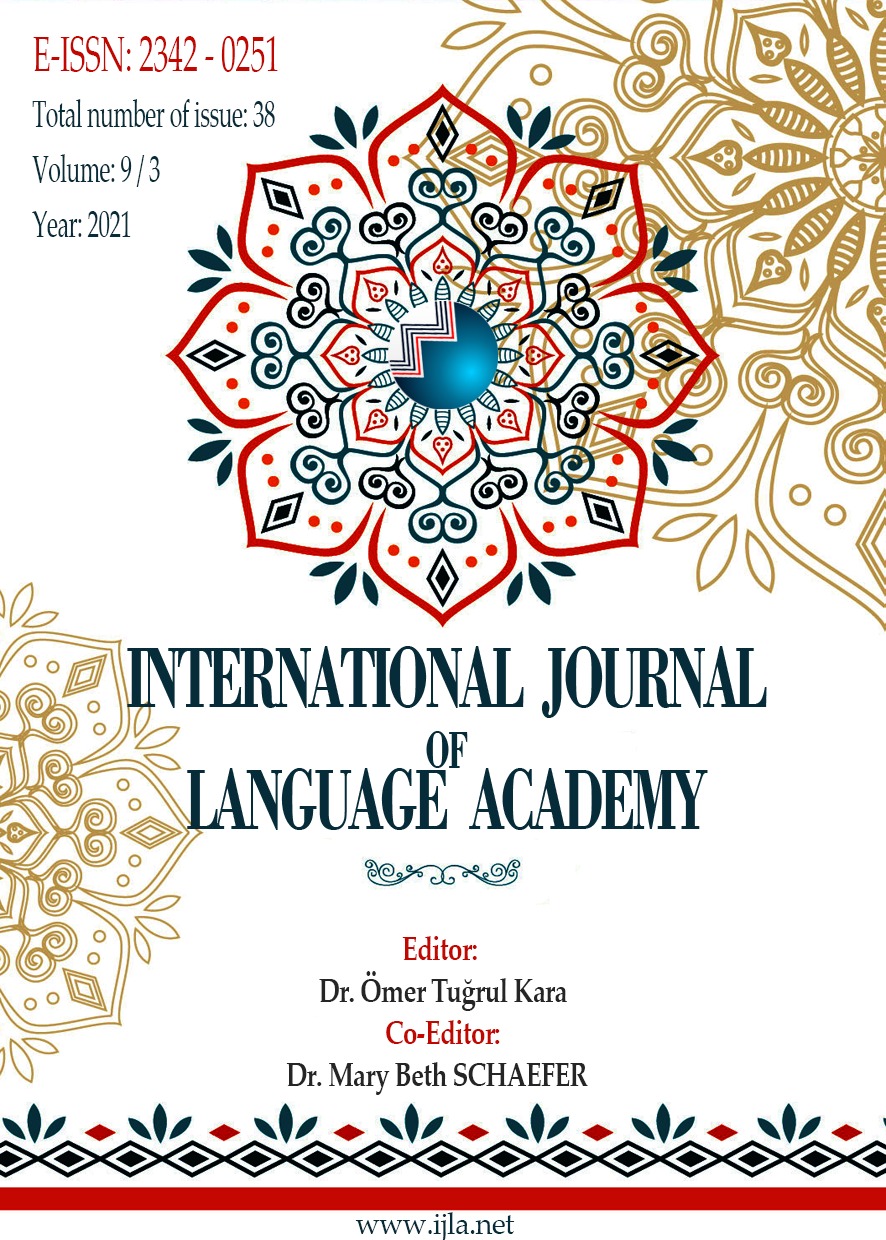Author :
Abstract
Keywords
Abstract
The purpose of the present study is to describe the diversity and frequency of rhetorical relations that ensure the consistency in informative texts in middle school (5th, 6th, 7th and 8th grades) Turkish language textbooks. Semantic relations in the texts were examined within the framework of Rhetoric Structure Theory, and the outlook of rhetorical relations were defined according to grade levels. Only informative texts in written form were selected from the textbooks and the selection of informative texts is based on the classification determined by the Ministry of National Education (MoNE). In the present study, paragraphs were considered as the basic unit, and the rhetorical relation outlooks that provided the consistency in the whole paragraphs and in the paragraph backgrounds were presented in the tables. It was observed that the relations used in the texts mostly made explicit the text types and the rhetorical relations differed in terms of frequency and diversity distribution according to grade levels.
Keywords
- Akyol, H. (2014). Turkish teaching methods suitable for the program. Ankara: Pegem Academy.
- Beaugrande, R.-A. d., & Dressler, W. (1981). Introduction to text linguistics. Londra: Longman.
- Bozkurt, B. Ü. (2019). Turkish teacher candidates' tendency to conceptualize text types and their genre awareness. Bolu Abant İzzet Baysal University Faculty of Education Journal, 86-102.
- Can, R. (2012). Paragraph level coherence and consistency in the written expressions of secondary school students (Unpublished Doctoral Thesis). Gazi University: Ankara.
- Çakır, Ö. (2003). The effect of the pattern on focusing on the sub-topics of the text in the reading recall process. Education and Science, 28(129), 32-36.
- Çeltek Kaili, A. (2014). The importance of discourse structure in teaching Turkish. In D. Yaylı & Y. Bayyurt, Teaching Turkish to foreigners: policy methods and skills (pp. 139-168). Ankara: Anı Publishing.
- Dilidüzgün, Ş. (2017). Textlinguistics and Turkish teaching. Ankara: Anı Publishing.
- Ekiz, D. (2015). Scientific research methods. Ankara: Anı Publishing.
- Fraenkel, J. R., Wallen, N. E., & Hyun, H. (2012). How to design and evaluate researche in/education. New York: McGraw-hill.
- Güneş, F. (2013). Learning with text instead of text teaching in Turkish. Adıyaman University Journal of Social Sciences Institute, Special Issue of Teaching Turkish, 603-637.
- İmer, K., Kocaman, A., & Özsoy, A. (2011). Linguistics Dictionary. Istanbul: Bogazici University Press.
- İşeri, K. (2010). Textuality features of texts in Turkish textbooks. Analysis of Turkish textbooks in H. Ülper (91-113). Ankara: Pegem Academy.
- İşeri, K. (2017). Word-to-text text. Ankara: Pegem Academy.
- Kaplan, R. B.(1972).The anatomy of rhetoric: prolegomena to a functional theory of rhetoric.
- Karasar, N. (2012). Scientific research method. Ankara: Nobel.
- Kehler, A. (1995). Interpreting cohesive forms in the context of discourse inference. Cambridge, Massachusetts: Center for Research in Computing Technology Harvard University.
- Korkut, E. (2016). Text linguistics and language teaching. E. Korkut, & İ.Onursal Ayırır. Linguistics and language teaching (p. 173-199). Ankara: Seçkin Publishing.
- Korkut, E. (2017). Word and identity. Ankara: Seçkin Publishing.
- Mann, W. C., & Thompson, S. A. (1988). Rethorical Structure Theory: toward a functional theory of text organization. Text, 8(3), 243-281.
- Mann, B. (1999, August). An Introduction to Rhetorical Structure Theory (RST). http://www.di.uniba.it/intint/people/fior_file/INTINT05/RST.pdf
- MONE. (2018a). Turkish language curriculum: http://mufredat.meb.gov.tr/ProgramDetay.aspx?PID=663
- MONE. (2018b). 5th grade Turkish textbook for secondary and imam hatip secondary schools. Ankara.
- MONE. (2018c). 6th grade Turkish textbook for secondary and imam hatip secondary
- MONE. (2018d). 7th grade Turkish textbook for secondary and imam hatip secondary
- MONE. (2018e). 8th grade Turkish textbook for secondary and imam hatip secondary
- Nicholas, N. (1994). Problems in the application of Rhetorical Structure Theory to text generation. Melbourne: University of Melbourne.
- Onursal, İ. (2003). Cohesion and consistency in Turkish texts. In A. Kıran, E. Korkut, & S. Ağıldere. Contemporary Linguistic Studies, 1-20.
- Oraliş, M., & Özil, Ş. (1992). An attempt to analyze a literary text with a textlinguistic approach. Linguistic Studies, p. 37-51.
- Sadiku, L. M. (2015). The importance of four skills reading, speaking, writing, listening in a lesson hour. European Journal of Language and Literature Studies, s. 30-32.
- Sarar Kuzu, T. (2004). The effect of reading instruction in accordance with the Interactive Model on the level of understanding Turkish informative texts. Journal of Ankara University Faculty of Educational Sciences, 37(1), p. 55-77.
- Selvikavak, E. (2006). An application on improving the paragraph writing skills of advanced students in teaching Turkish as a foreign language (Unpublished master's thesis). Ankara University: Ankara.
- Sidekli, S. (2018). Text teaching. In M.Yılmaz. Teaching Turkish in the light of new developments (p. 135-165). Ankara: Pegem Academy.
- Subaşı Uzun, L. (1995). Textlinguistic structure of the Orkhon Inscriptions. Istanbul: Simurg Book.
- Tok, M., & Küçük, B. (2014). Sources of student informative texts and evaluation of media elements. Uşak University Journal of Social Sciences.
- Turan, Ü. D., Zeyrek, D., & Bozşahin, C. (2012). Discourse and cohesion relations. Linguistic Studies, 41-65.
- Uzun, L. (2001). Self-formations specific to scientific texts and the act of writing scientific text. Anatolia: Journal of Tourism Studies, 197-204.
- Yaylı, D. (2010). Turkish curriculum and textbooks. In H. Ülper. Turkish textbook analyzes (pp. 21-36). Ankara.
- Yazıcı, N. (2004). Linguistic aspects that highlight the foreground and background in narrative texts: Observations on Turkish. (Unpublished doctoral dissertation). Ankara: Ankara University.
- Yılmaz, E., & Topal, Z. (2010). Textlinguistic analysis in Turkish teaching application of the method. Journal of Turkology Studies, 27, 775-788.





